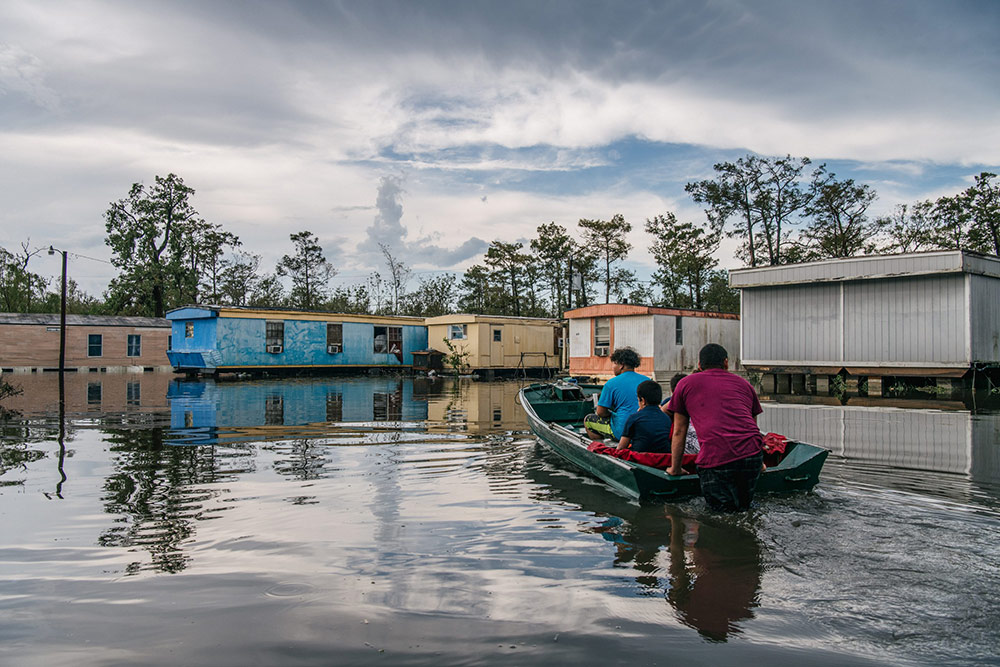
越来越多美国家庭可能因为气候相关灾难受到伤害,这种风险的严重程度是史无前例的。2021年,美国至少发生了20场造成损失超过10亿美元的灾难,灾后重建成本总计超过1,450亿美元。据估计,仅飓风艾达造成的经济损失就达到950亿美元。
极端气候事件发生的频率越来越高,越来越严重,但美国的国家减灾和灾后重建工作却并没有相应地加快速度。这种情况不能持续下去,而且美国国会和拜登政府有解决这个问题的方法。
每当爆发大灾难,联邦应急管理署都会提供初步紧急救援,包括提供短期租房和临时维修资金等。但当幸存者走出眼前的危险境地之后,长期救助就变得遥遥无期。
美国国会主要通过住房与城市发展部社区发展整笔拨款灾后恢复(CDBG-DR)计划,提供居民灾后恢复和重建资金,该计划可为各县、市和州输送灵活资源,用于提供贷款和资助,满足不属于保险范围或联邦应急管理署覆盖范围的重建需求。
当保险或联邦应急管理署的资助不足以维修房屋或帮助人们获得稳定的新住房时,该计划就成为满足这些需求的关键保障。CDBG-DR计划尤其注重对低收入社区的援助,通常至少70%的资源将使中低收入家庭受益。
与联邦应急管理署的灾后恢复计划不同,CDBG-DR计划无法迅速覆盖社区,因为该计划并没有获得永久授权。这意味着该计划首先需要获得国会批准,才能向受影响的地区提供资金。获得华盛顿批准只是第一步:CDBG-DR拨款需要经过漫长的审批过程,在此期间,准备接收资源的各州和地方必须制定新的资源分配方案和指南。城市研究院(Urban Institute)发现,CDBG-DR计划的资金,平均需在灾难发生后20个月,才能开始发放到受影响的业主手中。
联邦救助的严重延误,是一个不可接受的公平问题。虽然有办法的业主可以立即开始维修,并希望能获得赔偿,但许多最低收入家庭和有色人种在灾难中受到的影响更加严重,但却只能得到最少的援助,在短期援助计划结束后,他们将面临无家可归的处境,或者被迫搬迁。
许多家庭因为无法承受没有尽头的等待,于是选择了搬迁,搬到了没有经济保障或社会保障的新社区。有人虽然利用现有的有限资金开始重建,但却没有资金保证新家能够抵御未来的灾难。
应对这个挑战的解决方案可以分为两个方面。
首先,国会必须授予CDBG-DR计划永久授权。参众两院的国会领袖通过了《灾难恢复改革法案》(The Reforming Disaster Recovery Act),旨在改进美国漏洞百出的灾难恢复系统。这份两党法案将永久授权CDBG-DR计划,更高效、更公平地将灾难恢复资源送到受灾社区,改善受灾家庭的处境。参议员布莱恩·沙茨表示,这项法案“修改了法律,让[受灾家庭]无需漫长地等待援助。一旦发生灾难,HUD就可以帮助社区开始恢复。”
其次,私人市场应该介入,填补资金缺口。企业社区合作伙伴(Enterprise Community Partners)和摩根士丹利(Morgan Stanley)最近启动了一个规模高达2,500万美元的试点项目,旨在验证这个概念。该项目的首款产品是为多户经济适用房的业主提供过桥贷款,支持业主在等待长期援助的过程中,能够立即开始恢复过程。
我们首先从爱荷华州、路易斯安那州和俄勒冈州开始。这三个州在今年秋天可以从国会提供的50亿美元资金中获得联邦灾难恢复资源。这类计划可以在全国范围内展开,在公共灾难恢复资金到位之前,由私人企业提供短期资本,从而缩短灾难幸存者居住在临时住房或受损住房的时间。
每年,自然灾害和气候冲击事件变得越来越严重。曾经“数十年不遇的”风暴变得司空见惯。联邦资源必须加快发放速度,并做到更加公平。灾难援助不能等待。
本文作者普里西拉·阿尔莫多瓦现任全国经济适用房非营利机构企业社区合作伙伴的总裁兼首席执行官。(财富中文网)
译者:刘进龙
审校:汪皓
越来越多美国家庭可能因为气候相关灾难受到伤害,这种风险的严重程度是史无前例的。2021年,美国至少发生了20场造成损失超过10亿美元的灾难,灾后重建成本总计超过1,450亿美元。据估计,仅飓风艾达造成的经济损失就达到950亿美元。
极端气候事件发生的频率越来越高,越来越严重,但美国的国家减灾和灾后重建工作却并没有相应地加快速度。这种情况不能持续下去,而且美国国会和拜登政府有解决这个问题的方法。
每当爆发大灾难,联邦应急管理署都会提供初步紧急救援,包括提供短期租房和临时维修资金等。但当幸存者走出眼前的危险境地之后,长期救助就变得遥遥无期。
美国国会主要通过住房与城市发展部社区发展整笔拨款灾后恢复(CDBG-DR)计划,提供居民灾后恢复和重建资金,该计划可为各县、市和州输送灵活资源,用于提供贷款和资助,满足不属于保险范围或联邦应急管理署覆盖范围的重建需求。
当保险或联邦应急管理署的资助不足以维修房屋或帮助人们获得稳定的新住房时,该计划就成为满足这些需求的关键保障。CDBG-DR计划尤其注重对低收入社区的援助,通常至少70%的资源将使中低收入家庭受益。
与联邦应急管理署的灾后恢复计划不同,CDBG-DR计划无法迅速覆盖社区,因为该计划并没有获得永久授权。这意味着该计划首先需要获得国会批准,才能向受影响的地区提供资金。获得华盛顿批准只是第一步:CDBG-DR拨款需要经过漫长的审批过程,在此期间,准备接收资源的各州和地方必须制定新的资源分配方案和指南。城市研究院(Urban Institute)发现,CDBG-DR计划的资金,平均需在灾难发生后20个月,才能开始发放到受影响的业主手中。
联邦救助的严重延误,是一个不可接受的公平问题。虽然有办法的业主可以立即开始维修,并希望能获得赔偿,但许多最低收入家庭和有色人种在灾难中受到的影响更加严重,但却只能得到最少的援助,在短期援助计划结束后,他们将面临无家可归的处境,或者被迫搬迁。
许多家庭因为无法承受没有尽头的等待,于是选择了搬迁,搬到了没有经济保障或社会保障的新社区。有人虽然利用现有的有限资金开始重建,但却没有资金保证新家能够抵御未来的灾难。
应对这个挑战的解决方案可以分为两个方面。
首先,国会必须授予CDBG-DR计划永久授权。参众两院的国会领袖通过了《灾难恢复改革法案》(The Reforming Disaster Recovery Act),旨在改进美国漏洞百出的灾难恢复系统。这份两党法案将永久授权CDBG-DR计划,更高效、更公平地将灾难恢复资源送到受灾社区,改善受灾家庭的处境。参议员布莱恩·沙茨表示,这项法案“修改了法律,让[受灾家庭]无需漫长地等待援助。一旦发生灾难,HUD就可以帮助社区开始恢复。”
其次,私人市场应该介入,填补资金缺口。企业社区合作伙伴(Enterprise Community Partners)和摩根士丹利(Morgan Stanley)最近启动了一个规模高达2,500万美元的试点项目,旨在验证这个概念。该项目的首款产品是为多户经济适用房的业主提供过桥贷款,支持业主在等待长期援助的过程中,能够立即开始恢复过程。
我们首先从爱荷华州、路易斯安那州和俄勒冈州开始。这三个州在今年秋天可以从国会提供的50亿美元资金中获得联邦灾难恢复资源。这类计划可以在全国范围内展开,在公共灾难恢复资金到位之前,由私人企业提供短期资本,从而缩短灾难幸存者居住在临时住房或受损住房的时间。
每年,自然灾害和气候冲击事件变得越来越严重。曾经“数十年不遇的”风暴变得司空见惯。联邦资源必须加快发放速度,并做到更加公平。灾难援助不能等待。
本文作者普里西拉·阿尔莫多瓦现任全国经济适用房非营利机构企业社区合作伙伴的总裁兼首席执行官。(财富中文网)
译者:刘进龙
审校:汪皓
More American homes are at a greater risk of harm from weather-related disasters than at any point in our history. In 2021, the U.S. recorded at least 20 disasters that cost $1 billion or more in losses, totaling more than $145 billion in recovery costs. Estimates pegged the damage from Hurricane Ida at $95 billion—just for one single storm.
The frequency and severity of extreme weather events are increasing, but our national disaster mitigation and recovery efforts are not accelerating at even close to the same pace. This cannot continue–and Congress and the Biden-Harris administration have the tools to fix it.
When major disasters strike, FEMA steps in to provide initial emergency aid, including offering funds for basic short-term rental housing and temporary repairs. But once disaster survivors are out of immediate danger, the wait begins for long-term help.
Congress provides funding for residential disaster recovery and rebuilding efforts primarily through the Department of Housing and Urban Development’s Community Development Block Grant-Disaster Recovery (CDBG-DR) program, which funnels flexible resources to counties, cities, and states to provide loans and grants to address rebuilding needs not already covered by insurance or FEMA.
CDBG-DR has become a critical safeguard for filling any unmet needs if insurance proceeds and FEMA grants are insufficient to repair homes or get families to stable new housing. CDBG-DR particularly aids lower-income communities, with a typical program dedicating at least 70% of its resources to benefit low and moderate-income families.
Unlike FEMA’s disaster recovery programs, CDBG-DR cannot reach communities quickly because it is not permanently authorized. This means Congress must vote to approve its use before funds can be made available to impacted jurisdictions. The green light from Washington is only the first step: A CDBG-DR appropriation kicks off a lengthy approval process during which states and local jurisdictions that are set to receive resources must develop new programs and guidelines to distribute them. The Urban Institute found that it takes an average of 20 months after a disaster for CDBG-DR funds to begin reaching impacted property owners.
Such an extreme delay in federal relief is an unacceptable equity issue. While property owners with the means can start making repairs immediately and hope for reimbursement, many of the lowest-income households and people of color–who are disproportionately affected by disasters but receive the least amount of assistance–face homelessness or displacement when shorter-term assistance programs end.
Many families who cannot afford the indefinite waiting period start over elsewhere, moving to new communities without financial or social safety nets. Others use the limited funds they have on hand to rebuild, but often lack the capital to ensure their new homes are fortified against future disasters.
The solution to this challenge is twofold.
First, Congress must permanently authorize CDBG-DR. Congressional leaders in the House and Senate introduced The Reforming Disaster Recovery Act to ameliorate America’s ailing disaster recovery system. The bipartisan bill would permanently authorize the CDBG-DR program and improve outcomes for families by getting recovery resources to disaster-stricken communities in a more efficient and equitable way. This bill, according to Senator Brian Schatz, “changes the law so [families] no longer have to wait. As soon as a disaster strikes, HUD can help communities begin the process of recovery.”
Second, the private market should step in to provide financing to fill the gap. Enterprise Community Partners and Morgan Stanley recently launched a $25 million pilot program to prove this concept. This first-of-its-kind product will provide owners of multifamily affordable housing properties bridge loans to start the recovery process immediately while waiting for long-term assistance.
We are starting with Iowa, Louisiana, and Oregon, three of the states selected to receive federal disaster recovery resources from the five billion dollars Congress made available in the fall. Initiatives like this can be scaled nationwide, so that the private sector provides short-term capital until public recovery dollars arrive, shortening the time that survivors live in temporary or damaged housing.
Natural disasters and climate shocks are growing more severe with each passing year. Storms that were once considered “once in a generation” have become the norm. Federal resources must move faster–and more equitably–to keep pace. This cannot wait.
Priscilla Almodovar is president and chief executive officer of Enterprise Community Partners, a national affordable housing nonprofit.






